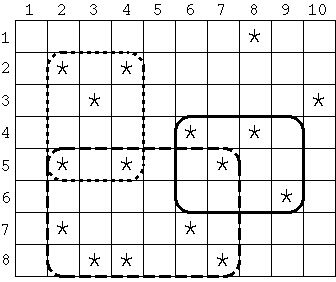Description
For example, in Figure 1, the entire field is a rectangular grid whose width and height are 10 and 8 respectively. Each asterisk (*) represents a place of a persimmon tree. If the specified width and height of the estate are 4 and 3 respectively, the area surrounded by the solid line contains the most persimmon trees. Similarly, if the estate's width is 6 and its height is 4, the area surrounded by the dashed line has the most, and if the estate's width and height are 3 and 4 respectively, the area surrounded by the dotted line contains the most persimmon trees. Note that the width and height cannot be swapped; the sizes 4 by 3 and 3 by 4 are different, as shown in Figure 1.

Figure 1: Examples of Rectangular Estates
Your task is to find the estate of a given size (width and height) that contains the largest number of persimmon trees.
Input
N
W H
x1 y1
x2 y2
...
xN yN
S T
N is the number of persimmon trees, which is a positive integer less than 500. W and H are the width and the height of the entire field respectively. You can assume that both W and H are positive integers whose values are less than 100. For each i (1 <= i <= N), xi and yi are coordinates of the i-th persimmon tree in the grid. Note that the origin of each coordinate is 1. You can assume that 1 <= xi <= W and 1 <= yi <= H, and no two trees have the same positions. But you should not assume that the persimmon trees are sorted in some order according to their positions. Lastly, S and T are positive integers of the width and height respectively of the estate given by the lord. You can also assume that 1 <= S <= W and 1 <= T <= H.
The end of the input is indicated by a line that solely contains a zero.
Output
Sample Input
16 10 8 2 2 2 5 2 7 3 3 3 8 4 2 4 5 4 8 6 4 6 7 7 5 7 8 8 1 8 4 9 6 10 3 4 3 8 6 4 1 2 2 1 2 4 3 4 4 2 5 3 6 1 6 2 3 2 0
Sample Output
4
就是二维树状数组的模板题 注意画的那个框的坐标就行 还有 lowbit中 有0 会死循环
#include <iostream>
#include<cstdio>
#include<cstring>
using namespace std;
int w,h;
int c[105][105];
int lowbit(int i)
{
return i&(-i);
}
void update(int x,int y,int v)
{
for(int i=x;i<=w;i+=lowbit(i))
{
for(int j=y;j<=h;j+=lowbit(j))
c[i][j]+=v;
}
}
int query(int x,int y)
{
int ans=0;
for(int i=x;i>0;i-=lowbit(i))
{
for(int j=y;j>0;j-=lowbit(j))
ans+=c[i][j];
}
return ans;
}
int main()
{
int n;
while(~scanf("%d",&n)&&n)
{
memset(c,0,sizeof(c));
scanf("%d%d",&w,&h);
while(n--)
{
int x,y;
scanf("%d%d",&x,&y);
update(x,y,1);
}
int s,t;
scanf("%d%d",&s,&t);
int max=-999;
for(int i=1;i+s-1<=w;i++)
{
for(int j=1;j+t-1<=h;j++)
{
int tmp=query(s+i-1,t+j-1)-query(s+i-1,j-1)
-query(i-1,t+j-1)+query(i-1,j-1);
if(tmp>max)max=tmp;
}
}
printf("%d\n",max);
}
return 0;
}
























 1319
1319

 被折叠的 条评论
为什么被折叠?
被折叠的 条评论
为什么被折叠?








